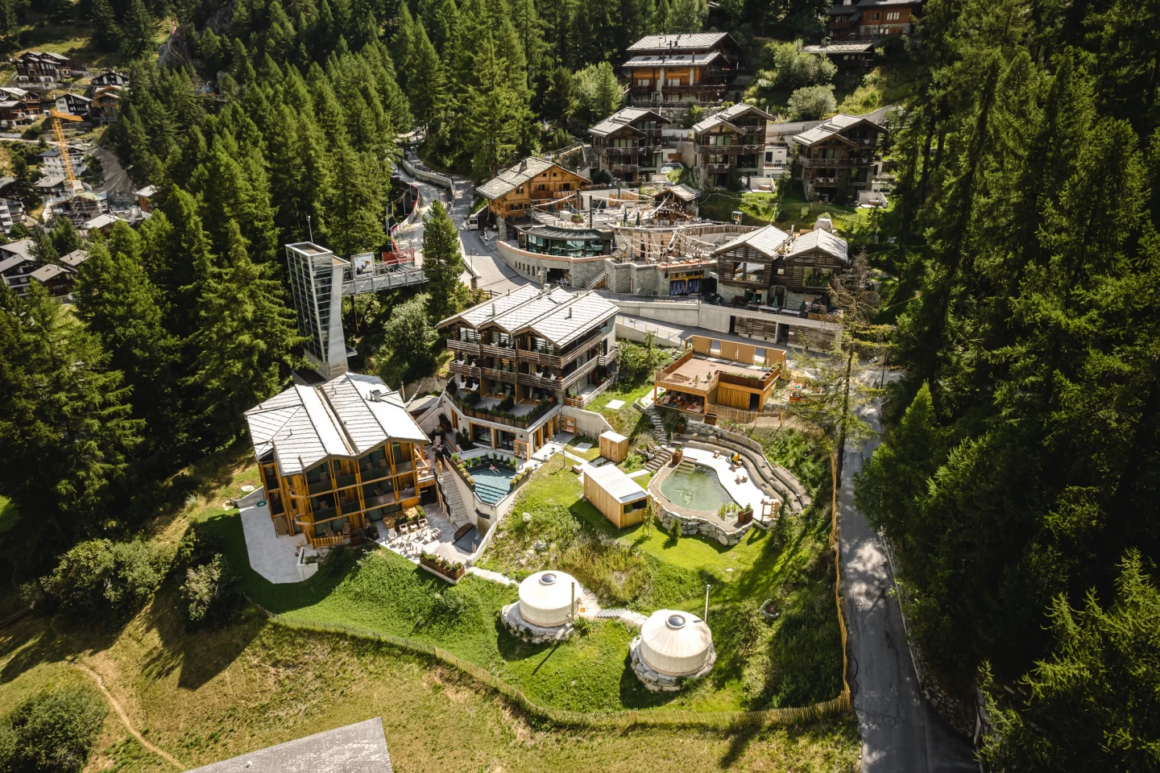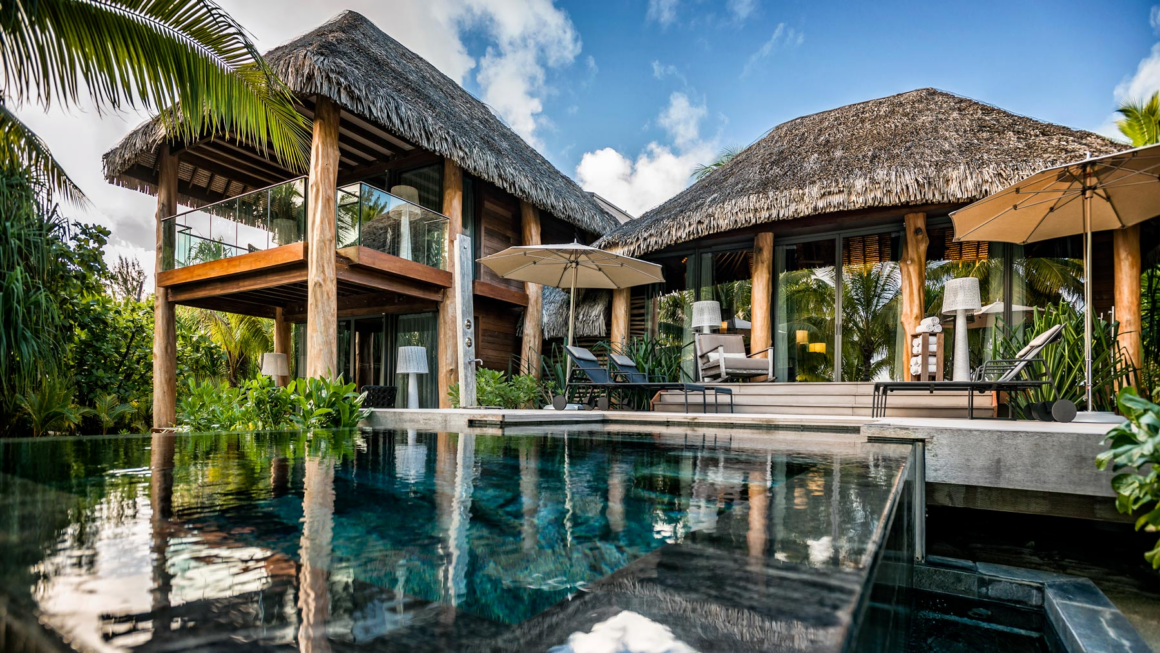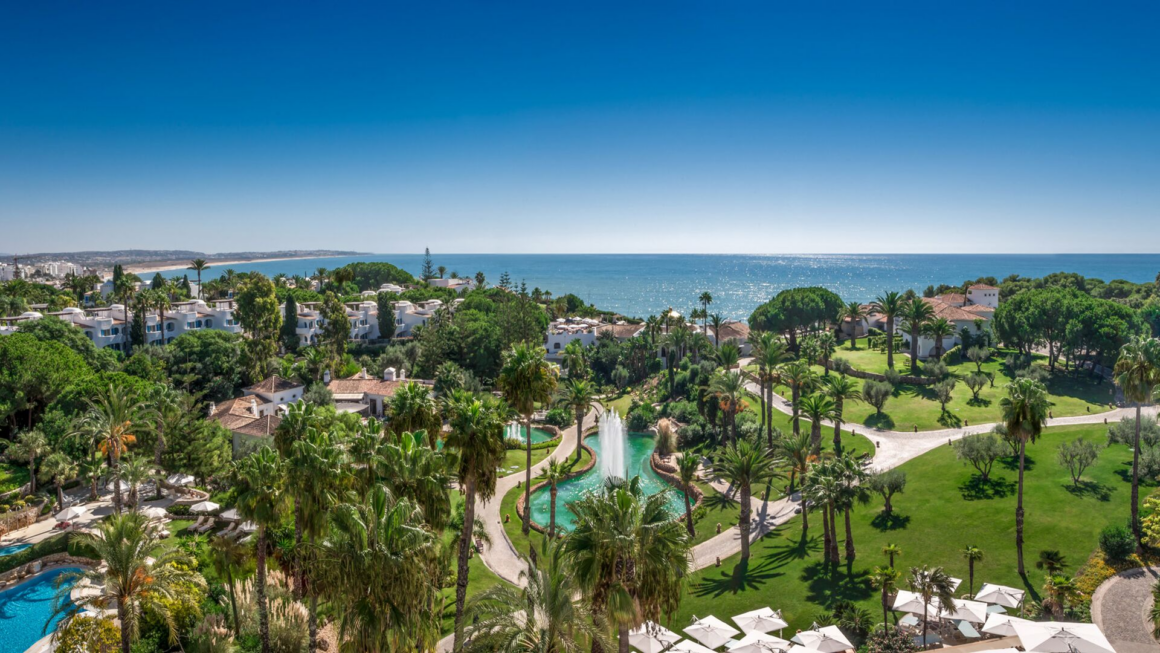The concept of sustainable design is becoming increasingly popular among designers as the need for eco-friendly and resource-conscious projects grows. Implementing sustainable techniques can be challenging within hotel architecture and interior design, but with hard work and innovation, there are many examples of sustainability being achieved in hotel designs across the globe.
From innovative materials repurposed from old factories and sustainable construction techniques to thoughtful energy conservation measures, these projects show that luxury, style, and sustainability are not mutually exclusive.
We'll take a closer look at ten of the best sustainably designed hotels worldwide that showcase how thoughtful conservation efforts can lead to stunning design results. Whether you’re looking for inspiration or want to learn about which green solutions have been put into practice in hospitality designs, read on to discover ten exemplary examples.


1. CERVO Mountain Resort | Switzerland
The CERVO Mountain Resort is a stunning four-star hotel nestled high in the Swiss and Italian Alps. The updated CERVO is a beautifully remodeled hotel for the modern nomad where sustainability, connection to nature, and a “glocal” experience are enjoyed amongst the majesty of the Matterhorn.
Redesigned by multi award-winning studio Dreimeta, led by Armin Fischer and Andrea Kraft-Hammerschall, the remodeled spaces feature a modern interpretation of the Alpine lifestyle.


Among the three types of accommodations—The Huntsman, The Nomad, and The Alpinist—that now populate CERVO, warm colors, wooden surfaces, and natural materials coalesce with timelessly modern accents and views of the Matterhorn.
Following an eight-month renovation process that commenced in the summer of 2020, the hotel now presents an updated mission statement in line with its physical reincarnation dedicated to people who "act and travel consciously."
Sustainable Design Elements
Cervo recently partnered with the Responsible Hotels Switzerland Alliance to ensure compliance with the highest sustainability standards. With a renewed directive to decrease its carbon footprint, these are a few of CERVO's sustainable highlights.
- Geothermal Heat. A newly implemented geothermal heat pump allows the hotel to generate up to 95 percent of its energy requirements for hot water and heating while depending far less on fossil fuels. By interconnecting its pipework installations, the hotel can efficiently recover heat from its wastewater; waste heat from operational refrigeration is directly utilized to produce hot water.
- Plant-based menus. CERVO's vegetarian Bazaar Restaurant only uses organic plant-based ingredients. In fact, the entire property is a member of Slow Food – an organization that sees itself as a countermovement to the globalized fast food trend.
- Local water. The only water served at tables on this property is purified mountain water originating from the town itself. In addition, 10% of the revenue from water sold in restaurants is donated to the Water Is Right Foundation to make water an equitable resource for all.
- Offset impact. Guests here are also offered the opportunity to compensate for part (or even all) of their stay through the myclimate program, an international climate protection organization with Swiss roots.


2. Bambu Indah | Bali
Bambu Indah was curated by American entrepreneur John Hardy and his family. After Hardy made money in the jewelry business, he reinvested it in green infrastructure in hospitality in Bali to great acclaim.
This property is a fever dream of luxurious hospitality, innovative nature-inspired architecture, and sustainable design elements. Nestled in the unadulterated nature of Bali's most lush tropical forests, Bambu Indah utilizes many of the surrounding resources in harmony with the property.


Sustainably Design Elements
This ecologically mindful jungle retreat nestled in the outskirts of the popular destination of Ubud goes to great lengths to live alongside rather than in nature.
- Farm to table. The food here is exclusively prepared from their local garden or neighboring farmers. Cooked in a bamboo kitchen, ingredients are organic, free of chemicals, and lack the carbon footprint of imported food.
- Air-conditioned beds. This property has invented air-conditioned beds, where mosquito netting captures cold air to keep you cool through the night rather than electricity-guzzling air conditioning systems.
- Natural filtration. The natural pool eschews electrical filtering systems and instead uses volcanic rock to filter water.
- Food scraps go to the pigs. Nothing goes to waste at Bambu Indah, including the food scraps which are fed to pigs or used in the compost heap to make naturally microbe-charged soil for the garden.
- No plastic. Removing plastic from hospitality is no small feat. For this property, that means using banana leaves for plates and papaya stems for straws.


3. Shonai Hotel Suiden Terrasse | Japan
With a history spanning centuries, Japanese architectural design is internationally acclaimed for its minimal beauty, harmony with nature, and sustainable efficiency.
Nowhere is this more apparent than in Shonai Hotel Suiden Terrasse - a small-scale sustainable hotel set amongst the rice paddies of Yamagata Prefecture. In fact, this hotel was designed to appear floating on the rice fields.
Taking full benefit of its unique rural views, specially curated libraries look out to the nature that abounds. Its unique blend of eco-conscious and culturally enriching design has drawn visitors from around the globe keen to explore both its beauty and sustainability potential.


Sustainable Design Elements
This art and culture-promoting property weaves sustainable elements into every corner.
- Farm to table dining. This property relies heavily on local agriculture and seasonal provisions. They also go another step in providing training for eco-friendly agricultural practices.
- Geothermal hot spring baths. You'll be kept warm in the properties naturally heated hot spring baths without using any electric.
- Wooded construction. The property prioritizes harmony with the surroundings in it's building elements. The use of wood over concrete as a dominant material leaves a smaller carbon footprint.


4. The Brando | French Polynesia
The Brando French Polynesia is an iconic resort on French Polynesian atolls. Thirty-five villas on white-sand beaches frequented by sea turtles, manta rays, and exotic birds greet guests. More than just a pretty facade, this property seamlessly integrates economic and social development principles with environmental protection principles.
The Brando provides a great example of this approach, showcasing four key elements that form the foundation for any successful sustainable design strategy: eco-resort infrastructure, renewable energy sources, conservation initiatives, and community engagement.


Sustainable Design Elements
The Brando is all in on creating a green promise with precise execution. This includes a "Green Team" that overstays every element of conservation and sustainability on the luxury property.
- Host scientific research. Beyond being operationally low impact, The Brando pays deep respect to the environment that it calls home by hosting scientists for research.
- LEED Platinum Certified. A designated LEED Platinum (Leadership in Energy and Environmental Design) certification means this property is in an elite sustainable company of other meticulously low-impact building designs.
- All natural building materials. All building materials used are of local or certified origin, renewable, or incorporate recycled components.
- Deep seawater air conditioning. Air conditioning is one of the most impactful elements in hospitality, especially in a humid environment where guests are likely to keep the cold breeze flowing. This property uses pioneering technology to reduce energy demand to provide their guest's cold air that doesn't cost the earth.


5. Terrestre Hotel | Mexico
Terrestre Hotel, is a small eco-boutique hotel located in the beach paradise eco heaven that is Tulum, Mexico. They've accomplished a small carbon footprint by adapting four key elements in their design. Each of Terrestre’s fourteen villas is designed around an earthy palette of colors and textures, which allows it to blend harmoniously with the outside areas.
Their use of solar energy, rainwater harvesting, passive building features, and green building materials make Terrestre an exceptionally well-designed green property.
Sustainable Design Elements
This property combines water, air, flora, and light elements to blend with sustainable design innovations.
- Natural materials. Terrestre is built with all-natural materials. Earth, wood, brick, and concrete are delicately combined with clay and sand to immerse visitors in a unique spatial experience where nature and architecture interact almost seamlessly.
- Solar powered. This property operates completely off the grid instead of using earth's natural electricity, solar, to power 100% of the hotels needs.
- Built-in cooling. Terrestre was built with keeping guests cool in mind using natural materials and architectural elements to cool down the property in place of air conditioning.


6. Azulik Hotel | Mexico
The Azulik Hotel in Tulum, Mexico, dubbed the Guggenheim Of The Jungle by the Financial Times, is a testament to sustainable design's future. From its elevated eco-design core and impeccable nature-based architecture to its captivatingly minimalist approach to luxury amenities, this incredible hotel complex is an awe-inspiring example of how modern hospitality can harmonize with Mother Nature.
The forty-eight villas of AZULIK have been designed to create an atmosphere for rest and reconnection. They forgo air conditioning, television, or electric light, in favor of reducing letting guests get in tune with their surroundings.
Azulik integrates powerful environmental concepts like permaculture, xeriscaping, renewable energy production, and efficient water management, proving that even the most ambitious visions for sustainable living are achievable.


Sustainable Design Elements
This property is sustainability personified from the building materials to the amenities.
- Nature is incorporated. Azulik brings new energy to what it is to be "one with the environment." There are over 200 trees that are part of the structure of the property. No trees were cut down in its construction but rather built within the structure.
- Local eats. Azulik builds on its reconnection and healing themes by sourcing ingredients locally to make far eastern and ancient Mexican fare.
- Low energy footprint. Thankfully there's plenty to see and experience on this property. You'll hardly notice the lack of phones, television or the internet.


7. The Pig at Combe | United Kingdom
The Pig at Combe, located in the heart of Devon, prides itself on its advanced sustainable design elements. Dedicated to a philosophy of responsible and thoughtful architecture, their mission is to bring an environment that is harmonious with the surrounding landscape and respects the small details that make a huge difference when planning for the future.
Twelve cozy rooms are located inside the vine-laden walls of this country-chic establishment, one of eight properties in The Pig family. Some even overlook chicken runs that supply the morning's breakfast.
Some of their carefully crafted sustainable hotel design choices, from renewable energy sources to zero waste methods, aim to create a sustainable lifestyle without compromising on comfort or luxury.


Sustainable Design Elements
- LED lighting. All lighting on this property is illuminated by energy-efficient LED bulbs that last longer and require less power.
- Recyclable materials. The Pig uses reclaimed and natural building materials where possible across the property. They also upcycle furniture where possible to give the pieces a second life.
- Garden, greenhouse, kitchen dining. Sourcing ingredients locally goes a tremendous way in decreasing the supply chain footprint felt with imported foods. The Pig, is a sustainable hotel design, and is located just 8 miles from the sea. Making the supply chain quite short for seafood. In addition, local Devonshire cheese isn't just fresh, it also reduces energy using refrigerated travel needed for dairy products.


8. Hotel Bardessono | USA
Hotel Bardessono in California's Napa Valley takes the sustainability concept to a new level with its innovative green building practices, modern amenities, and an overall commitment to environmental responsibility – elements that make it one of the most successful sustainable design hotels in the world.
Groomed gardens and a genuine farmstead create an authentically "off the grid" feeling within Hotel Bardessono's sixty-two rooms. Dubbed "personal havens," some even feature bespoke private patios and enclosed courtyards.
From its solar array on the roof to its low-flow water fixtures and use of recycled materials throughout, each aspect of Bardessono has been carefully crafted for maximum efficiency and minimal environmental impact.


Sustainable Hotel Design Elements
Bardessono's "deep green" mission has led to many eco-initiatives of note.
- Geothermal energy. An underground geothermal system is used to heat and cool guest rooms, the spa, and the domestic hot water supply. Almost no offsite energy is used.
- Solar. Hidden on the flat rooftops are 940 solar panels that provide significant amounts of the hotel’s electrical demand - reducing the need to pull finite environmental resources from the grid.
- Reclaimed wood. Enchanting wood features used across the property were sourced from milled salvaged trees eliminating virgin wood that plays into deforestation.
- Respect for natural surroundings. Property growth is held back from the nearby creek and is landscaped with native plants with the goal of creating a healthy vegetative environment for native animals and fish.


9. Vila Vita Parc | Portugal
Vila Vita Parc in Algarve, Portugal, was recently acknowledged by Conde Nast Traveler as part of the 2022 Hot List. This accolade wasn't just because it is a luxurious urban paradise but also because it leads in hospitality-related eco-efficiency.
Its two hundred rooms, eleven restaurants, and six bars manage to still feel private and secluded. This property has quickly become a benchmark of luxury for the Algarve area.
Drawing its energy from renewable sources such as solar panels and wind turbines and harvesting rainwater to sustain irrigation systems, Vila Vita has established itself as a leader in green development. Perhaps even more amazing is how seamlessly it integrates nature into the resort structure while still maintaining its relaxed five-star atmosphere.


Sustainable Design Elements
Crowned the World's Leading Luxury Green Resort in 2016, this 50-hectare estate brings a green vision into many of the design elements around the property.
- Seawater. A seawater desalination system provides the water for gardens and natural pools around the property.
- Farm-to-fork dining. From home-reared meat to olive oil, fresh compotes to jams, all are directly sourced from local farms. Within the meat production process, Vila Vita commits to raising free-range animals.
- Portugal's first eco-beach. The property is towards having its 300-meter beachfront, Armação Beach Club, becoming the first designated eco-beach in the country.


10. Svart | Norway
The Svart, located on the Svartisen Glacier, finds itself comfortably in the "ultra sustainable"hospitality category. Situated in the breathtaking Arctic Circle Wilderness region, it is the world's first energy-positive hotel resort.
One hundred bespoke rooms feature breathtaking 360-degree views of the surrounding pristine Arctic terrain giving an unheralded up close and personal experience with nature.
Designed around sustainability principles and environmental stewardship, Svart provides guests with a uniquely immersive experience that combines nature conservation efforts with luxury accommodations. From an innovative architectural design to thoughtful features throughout the building, Svart utilizes cutting-edge green technologies and materials to coexist harmoniously within its natural environment.


Sustainable Design Elements
- Solar energy. The circularly minded property aims to reduce its yearly energy consumption by 85%, compared to other modern hotels, by using solar energy.
- Off-the-grid plans. Svart's goal is to enable full off-grid operation within five years of its opening to become the first fully carbon-neutral and emission-free hotel.
- Offset impact. By offsetting each guest's journey from its very first booking request using its cutting-edge technology via Net Zero Labs, Svart creates a carbon-neutral environment.
- Green foundation. A strict Sustainable Framework developed by Svart tracks and reports on all our projects using a Green Framework. This was put together to ensure that any funds raised by Svart are used to benefit the environment.
Sustainability In Hospitality Is A Win For All
Sustainable design is important for the future of our planet, and hotels are uniquely positioned to lead the way. From the tech-disconnected jungles of Tulum to the tech-enriched glaciers of Norway, sustainably comes in all forms.
Check out our other hints on sustainable interior design with our interview with Mauricio Nava.




